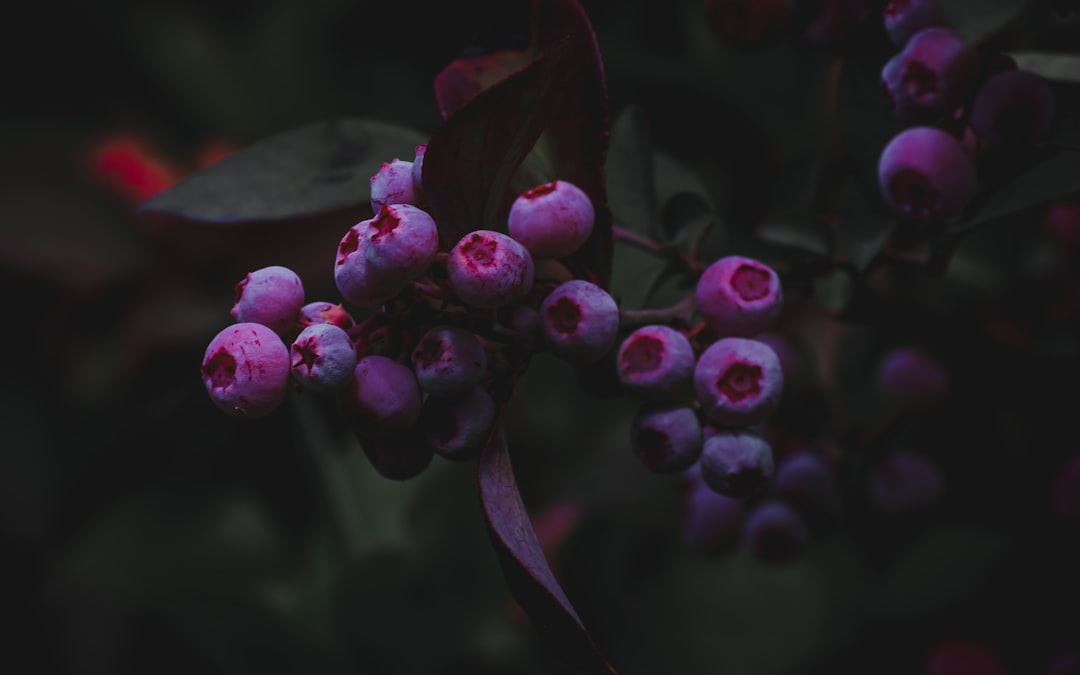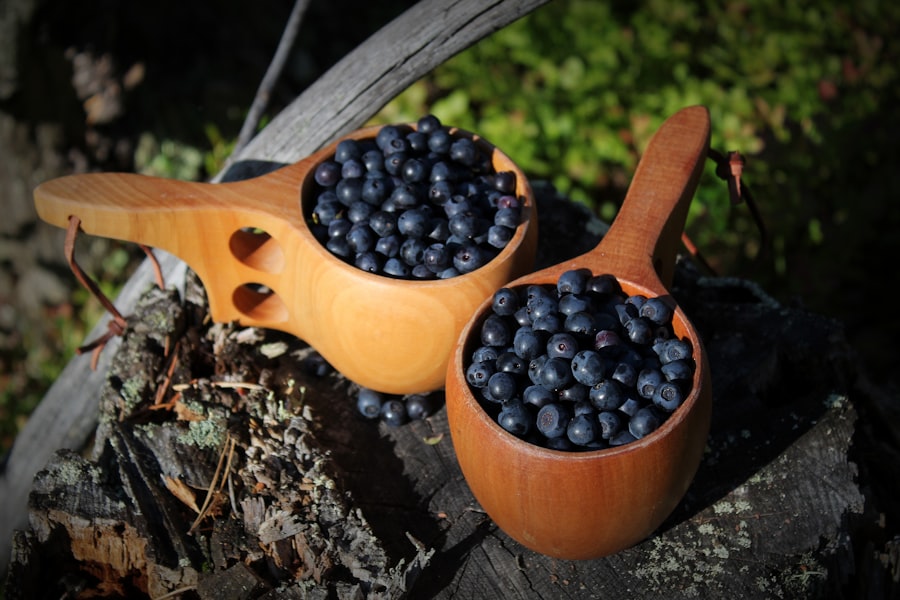Growing Delicious Blueberries: Tips and Tricks

Blueberries are not only delicious, but they also offer numerous health benefits. They are packed with antioxidants, vitamins, and minerals that can boost your immune system and improve your overall well-being. Growing blueberries at home allows you to have a fresh supply of these nutritious berries right at your fingertips. However, it is important to choose the right variety for your area to ensure optimal growth and yield.
Choosing the Right Variety of Blueberries for Your Area
When selecting blueberry varieties, there are several factors to consider. One of the most important factors is the climate in your area. Blueberries thrive in acidic soil with a pH level between 4.5 and 5.5, so it is crucial to choose a variety that is well-suited to your region’s climate and soil conditions.
Recommended blueberry varieties for different regions include:
– Northern Highbush: These varieties are best suited for colder climates with long, cold winters and short growing seasons. Some popular northern highbush varieties include ‘Bluecrop,’ ‘Jersey,’ and ‘Patriot.’
– Southern Highbush: These varieties are ideal for regions with mild winters and hot summers. They require fewer chill hours than northern highbush varieties. Recommended southern highbush varieties include ‘Emerald,’ ‘Jewel,’ and ‘Star.’
– Rabbiteye: Rabbiteye blueberries are well-suited for warmer climates with long, hot summers. They are more tolerant of heat and drought than other blueberry varieties. Some popular rabbiteye varieties include ‘Climax,’ ‘Premier,’ and ‘Tifblue.’
You can purchase blueberry plants from local nurseries, garden centers, or online retailers specializing in fruit plants. It is important to buy plants from reputable sources to ensure that you are getting healthy, disease-free specimens.
Preparing the Soil for Optimal Blueberry Growth
Blueberries have specific soil requirements for optimal growth. They prefer well-draining soil that is rich in organic matter. Before planting blueberries, it is important to test the soil pH and make any necessary adjustments. Blueberries thrive in acidic soil with a pH level between 4.5 and 5.5.
To lower the pH of the soil, you can add elemental sulfur or aluminum sulfate. It is important to follow the instructions on the product label and make adjustments gradually over time to avoid shocking the plants. It may take several months to achieve the desired pH level, so it is best to test the soil well in advance of planting.
In addition to adjusting the pH, adding organic matter to the soil can improve its structure and fertility. Compost, well-rotted manure, or peat moss can be incorporated into the soil before planting to provide essential nutrients and improve moisture retention.
Fertilizing Blueberry Plants for Maximum Yield
| Fertilizer Type | Application Rate | Timing | Nutrients Provided |
|---|---|---|---|
| Ammonium sulfate | 1 lb per plant | Early spring before bud break | Nitrogen and sulfur |
| Urea | 1 lb per plant | Early spring before bud break | Nitrogen |
| Blood meal | 1 lb per plant | Early spring before bud break | Nitrogen |
| Bone meal | 1 lb per plant | Early spring before bud break | Phosphorus and calcium |
| Fish emulsion | 1 cup per plant | Mid-spring after fruit set | Nitrogen, phosphorus, and potassium |
| Compost | 2-3 inches around plant | Early spring and mid-summer | Various nutrients |
Blueberry plants have specific nutrient requirements for optimal growth and maximum yield. They require a balanced fertilizer that is high in nitrogen, phosphorus, and potassium (NPK). However, it is important to avoid over-fertilization, as this can lead to excessive vegetative growth and reduced fruit production.
It is best to fertilize blueberry plants in early spring before new growth begins. A slow-release fertilizer specifically formulated for acid-loving plants is recommended. Follow the instructions on the product label for application rates and timing.
In addition to regular fertilization, it is beneficial to mulch around blueberry plants with organic matter such as wood chips or pine needles. This helps conserve moisture, suppress weeds, and provide a slow release of nutrients as the mulch breaks down.
Watering Blueberry Plants: How Much and How Often?
Proper watering is essential for the health and productivity of blueberry plants. Blueberries have shallow root systems, so they require consistent moisture to thrive. However, overwatering can lead to root rot and other diseases, so it is important to find the right balance.
Blueberry plants require about 1 to 2 inches of water per week, either from rainfall or irrigation. It is best to water deeply and infrequently rather than shallowly and frequently. This encourages the roots to grow deeper into the soil in search of moisture.
To avoid common watering mistakes, it is important to monitor the moisture level of the soil. Stick your finger into the soil up to the second knuckle. If it feels dry at that depth, it is time to water. It is also important to water in the morning or early afternoon to allow the foliage to dry before evening, which can help prevent fungal diseases.
Pruning Blueberry Bushes to Encourage Healthy Growth

Pruning blueberry bushes is essential for maintaining their health and productivity. Pruning helps remove dead or diseased wood, improves air circulation, and encourages new growth. It also helps maintain the shape and size of the bushes.
The best time to prune blueberry plants is in late winter or early spring before new growth begins. Start by removing any dead or damaged wood. Then, thin out any crowded branches to improve air circulation and reduce the risk of disease.
It is also important to remove any low-growing branches that may touch the ground, as this can increase the risk of pests and diseases. Finally, prune back any overly long or leggy branches to encourage bushier growth.
Protecting Blueberry Plants from Pests and Diseases
Blueberry plants are susceptible to a variety of pests and diseases that can reduce yield and damage the plants. Common pests that affect blueberries include aphids, spider mites, fruit flies, and birds. Diseases such as powdery mildew, leaf spot, and root rot can also be problematic.
Prevention is key when it comes to protecting blueberry plants from pests and diseases. Proper cultural practices, such as maintaining good air circulation, removing fallen leaves and debris, and avoiding overwatering, can help prevent many common problems.
If pests or diseases do become a problem, there are several treatment options available. For pests, insecticidal soaps or horticultural oils can be used to control aphids and spider mites. Netting or bird scare devices can help deter birds from eating the berries.
For diseases, fungicides may be necessary to control powdery mildew or leaf spot. It is important to follow the instructions on the product label and apply treatments at the first sign of trouble.
Organic pest and disease control methods are also available for those who prefer to avoid synthetic chemicals. These methods include using beneficial insects, such as ladybugs or lacewings, to control aphids, and applying organic fungicides made from ingredients like neem oil or copper.
Harvesting Blueberries: When and How to Pick Them
Knowing when to harvest blueberries is crucial for enjoying the best flavor and texture. Blueberries are ready to harvest when they are fully ripe and have a deep blue color. They should come off the plant easily with a gentle tug.
To determine if blueberries are ripe, taste a few berries from different parts of the bush. If they are sweet and juicy, they are ready to be picked. If they are still tart or firm, they need more time to ripen.
The best time of day to harvest blueberries is in the morning when the berries are cool and firm. Avoid harvesting in the heat of the day, as this can cause the berries to become soft and mushy.
When picking blueberries, use a gentle twisting motion to remove them from the plant. Be careful not to squeeze or crush the berries, as this can cause them to spoil more quickly. Place the harvested berries in a shallow container to avoid crushing the lower layers.
Storing Blueberries: Tips for Keeping Them Fresh
To keep fresh blueberries at their best, it is important to store them properly. Blueberries are delicate and can spoil quickly if not handled and stored correctly.
Fresh blueberries should be stored in the refrigerator, preferably in a shallow container lined with paper towels to absorb excess moisture. Do not wash the berries until you are ready to use them, as moisture can cause them to spoil more quickly.
Blueberries can also be frozen for long-term storage. To freeze blueberries, spread them out in a single layer on a baking sheet and place them in the freezer until they are firm. Once frozen, transfer the berries to airtight containers or freezer bags.
Canned blueberries are another option for preserving the harvest. Blueberries can be canned in syrup or made into jams and jellies. Follow a trusted recipe and canning guidelines to ensure safe and delicious results.
Using Blueberries in Cooking and Baking: Delicious Recipes to Try
Blueberries are incredibly versatile and can be used in a wide variety of recipes. They add a burst of flavor and natural sweetness to both sweet and savory dishes.
For breakfast, try adding blueberries to pancakes, waffles, or oatmeal. They can also be blended into smoothies or added to yogurt for a quick and nutritious snack.
In baking, blueberries are a classic addition to muffins, scones, and pies. They can also be used in cakes, tarts, and cobblers. Blueberry preserves or compote can be used as a topping for pancakes or ice cream.
Blueberries can also be incorporated into savory dishes such as salads, sauces, and marinades. They pair well with ingredients like goat cheese, balsamic vinegar, and fresh herbs.
Whether you prefer sweet or savory, there are countless ways to enjoy the delicious flavor of blueberries in your cooking and baking.
Propagating Blueberry Plants: How to Grow More from Cuttings or Seeds
If you want to expand your blueberry patch or share plants with friends and family, propagating blueberry plants is a cost-effective and rewarding option. Blueberries can be propagated from cuttings or seeds.
To propagate blueberry plants from cuttings, select healthy, disease-free stems from the current season’s growth. Cut the stems into 4 to 6-inch sections and remove the leaves from the lower half. Dip the cut ends in rooting hormone and plant them in a well-draining rooting medium. Keep the cuttings moist and warm until roots develop, which usually takes several weeks.
Blueberries can also be grown from seeds, although this method is less common. To grow blueberries from seeds, collect ripe berries and remove the pulp. Rinse the seeds and allow them to dry for a few days. Plant the seeds in a well-draining potting mix and keep them moist until they germinate, which can take several weeks.
It is important to note that blueberries grown from seeds may not produce fruit that is true to the parent plant. It can take several years for seed-grown blueberries to reach maturity and start producing fruit.
Growing blueberries at home can be a rewarding experience that allows you to enjoy fresh, nutritious berries right in your own backyard. By choosing the right variety for your area, preparing the soil properly, providing adequate water and nutrients, and protecting your plants from pests and diseases, you can ensure optimal growth and maximum yield.
Harvesting blueberries at their peak of ripeness and storing them properly will help you enjoy their delicious flavor all year round. And with countless recipes and cooking ideas, you can incorporate blueberries into a wide variety of meals and snacks.
So why not start growing blueberries at home? With a little bit of planning and care, you can enjoy the many benefits of these delicious and nutritious berries.



